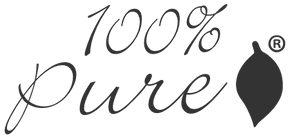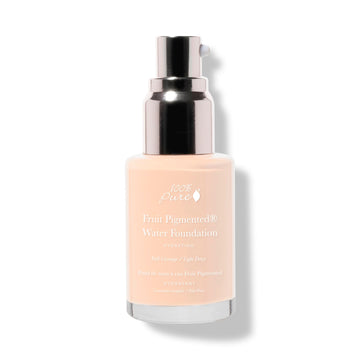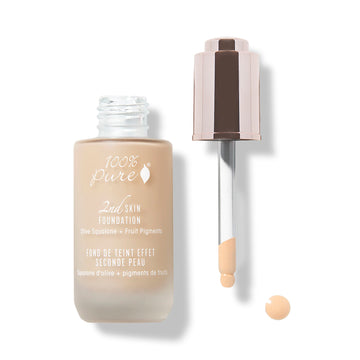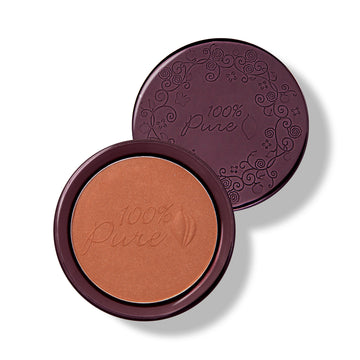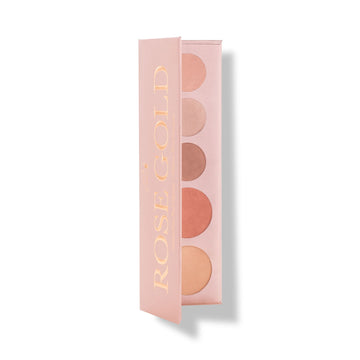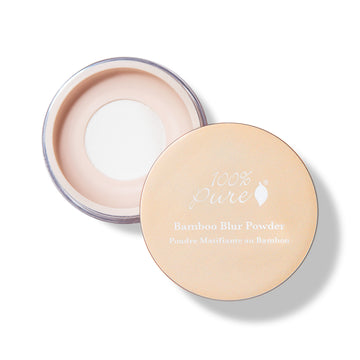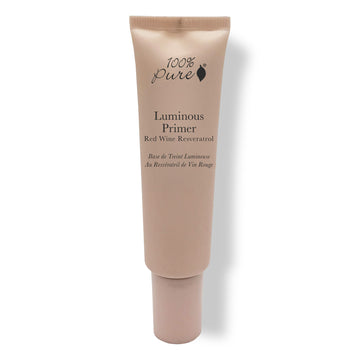Discover the basics of contour makeup—from how it works to where to apply it—using clean, skin-loving products
Posted on May 4, 2025 Written by: 100% PURE®
Contouring has evolved from a backstage beauty secret to a trusted step in everyday makeup routines. Once seen only on celebrities walking red carpets or posing under studio lights, it’s now embraced by makeup lovers everywhere.
But at its core, contouring isn’t about transformation—it’s about enhancement. The true purpose is to accentuate the natural angles and structure of the face, not to conceal them. When done right, it brings subtle definition and balance, allowing your features to shine through with confidence and ease. It’s not about changing your face—it’s about celebrating it.
What Is Contour Makeup and How Does It Work?
Contouring is a makeup technique that enhances your face’s natural shape by using light and shadow to create depth, definition, and lift. The idea is simple: darker shades recede, lighter shades bring features forward—mimicking how light naturally hits the face.
Apply contour (a few shades deeper than your skin tone) to areas like the hollows of your cheeks or sides of your nose. Then, highlight the high points—cheekbones, brow bones, and nose bridge—for balance and lift. But placement isn’t everything—color matters too. Cool or neutral-toned contours mimic real shadows and blend more naturally. Orangey bronzers can look too warm for sculpting.
Tip: Beginners should reach for cool or neutral tones for the most believable, flattering results.
Your Beginner Contour Kit: What You Really Need
Step 1: Prime the Skin
Start with a luminous primer to smooth out skin texture and create a hydrated, even base for layering products. This step helps everything blend better and stay put throughout the day.
Step 2: Choose the Right Base
Whether you opt for foundation or concealer, a smooth base is essential.
Full Coverage Water Foundation offers more pigment and creates a flawless canvas—ideal for a more defined contour.
2nd Skin Foundation is lightweight and perfect for a natural, skin-like finish if you prefer something subtle.
Step 3: Pick Your Contour Product
For beginners, powders are a great place to start. A product like Cocoa Pigmented Bronzer is easy to control and build gradually.
Why powder? It’s more forgiving than cream or liquid formulas and blends easily without needing advanced techniques.
Step 4: The Right Tools
Using the right tools makes a huge difference:
Blending brushes for smooth transitions
Angled brushes for precision in cheekbones and jawline
Beauty sponges (optional) work well for cream contours if you explore them later

Where to Apply Contour: A Step-by-Step Beginner Guide
The key to contouring lies in mastering where and how to apply these shades, making your features stand out without overwhelming them.
Cheekbones
To find your natural hollow, suck in your cheeks. Start applying contour at the top of your ear and blend toward the middle of your cheek.
Jawline
Apply contour directly under your jaw, not on the sides of your face. Blend downward to avoid harsh lines and create a smooth transition.
Forehead
Optionally, apply a light contour along your hairline to balance the proportions of your face, especially if you have a larger forehead.
Nose (Optional)
For beginners, keep the nose contour subtle and save it for later as you gain confidence in your technique.
How to Blend Like a Pro
The secret to seamless contouring is blending. Use circular motions with light pressure to blend the contour and highlight products into your skin. Always blend upward, not downward, to lift the face and create a more natural, sculpted look.
Clean Brush Technique
To soften harsh lines, use a separate, clean brush after blending. This will help ensure a smooth transition between the contour and highlight, preventing any noticeable demarcation lines.
Layering for Control
Start with a light application and gradually build up the product. It's always easier to add more than to try and remove excess, so take your time and build the contour slowly for a flawless finish.
Highlighting & Setting
Highlighting adds that beautiful glow and emphasis to the high points of your face. Apply a light layer above your cheekbones, along the brow bone, and in the center of your forehead. For a clean, natural finish, use soft shimmer or satin tones, like those found in the Rose Gold Palette.
To lock your makeup in place without making it look cakey, use Bamboo Blur Powder to lightly set everything. A light dusting will keep everything in place while maintaining that soft finish.
Common Contour Mistakes + How to Fix Them
Too Harsh?
If your contour looks too intense, simply reblend and tone it down using foundation or a clean brush. This will help soften the lines and create a smoother transition.
Too Orange or Muddy?
If your contour looks orange or muddy, switch to cooler-toned products, like Cocoa Pigmented Bronzer. Cooler shades mimic natural shadows and blend more seamlessly into your skin.
Disappears Completely?
If your contour fades away, choose a shade that's 1–2 tones deeper than your skin tone. Apply it in light layers, building up gradually to achieve the desired depth without overdoing it.
Patchy or Uneven?
Patchy contouring usually means your skin prep isn’t quite right. Ensure your skin is well-moisturized and primed with Luminous Primer for a smooth, even base that helps makeup blend more easily.
Customizing Contour by Face Shape
Every face can’t be contoured in the same way. Here’s a quick guide to customizing your contour for different face shapes:
Oval: Focus contour on the cheekbones to accentuate their natural structure.
Round: Add definition to the cheeks and jawline to create more angles and elongate the face.
Square: Soften the angles around the jaw and temples for a more rounded, gentle appearance.
Heart: Contour the temples and balance the chin to create symmetry and harmony.
Long/Oblong: Add contour along the forehead and chin to shorten the vertical length of the face, bringing balance.

Practice Makes Perfect: Your Beginner Contour Timeline
Mastering contouring is a gradual process, and with practice, you'll see steady improvement. Here’s a beginner’s timeline to help you build confidence and skills:
Week 1-2
Focus on perfecting contouring your cheekbones. Get comfortable with the basics and find your rhythm.
Week 3-4
Expand to adding definition to the jawline and forehead to create a more sculpted look.
Week 5+
Start exploring subtle nose contouring and focus on balancing the full face for a more refined result.
With each step, you’ll grow more comfortable and skilled, so take your time and enjoy the process!
Contouring Essentials
Contouring is all about enhancing your natural features, not transforming them. With the right products—like 2nd Skin Foundation, Cocoa Pigmented Bronzer, and Bamboo Blur Powder—you can create a subtle definition that lifts and sculpts. Remember, the goal is to make your features stand out, not to mask them.
FAQ Section
What is contour makeup and why should I use it?
Contouring is a makeup technique used to define and sculpt the face by creating shadows and highlights. It enhances your natural bone structure, adding depth and lift to features like your cheekbones, jawline, and nose. Contouring can help create a more balanced, chiseled appearance without needing heavy makeup.
How do I know if I should use concealer vs foundation first?
Start with the foundation to create an even, smooth base. It helps to cover any imperfections and provides a canvas for contouring. Concealer should come afterward, to brighten areas like the under-eyes, and to cover any spots or blemishes. This order helps you blend seamlessly without disrupting your base.
What's the best contour product for beginners?
For beginners, powder contours are the easiest to work with. They’re forgiving, blend well, and allow you to build up gradually. Try something like Cocoa Pigmented Bronzer for a natural, neutral tone that mimics real shadows. Powder contours are less intimidating than cream or liquid formulas and provide a softer finish.
Can I use bronzer instead of contour?
While bronzer adds warmth and a sun-kissed glow, it doesn’t define your face the way contouring products do. Contour products are cooler and designed to mimic natural shadows, while bronzers are warmer and meant for adding dimension. If you don’t have contour products, you can use bronzer lightly in a pinch, but it won’t give you the same sculpted effect.
What’s the difference between setting powder vs finishing powder?
Setting powder is used to lock in your makeup and prevent it from moving throughout the day. It helps to mattify and ensure your makeup stays in place. Finishing powder, on the other hand, is used to blur imperfections, smooth texture, and give your skin a soft, airbrushed look. It’s often translucent and adds a polished finish.
- Tags: May-2025
We carefully hand-select products based on strict purity standards, and only recommend products we feel meet this criteria. 100% PURE™ may earn a small commission for products purchased through affiliate links.
The information in this article is for educational use, and not intended to substitute professional medical advice, diagnosis, or treatment and should not be used as such.
